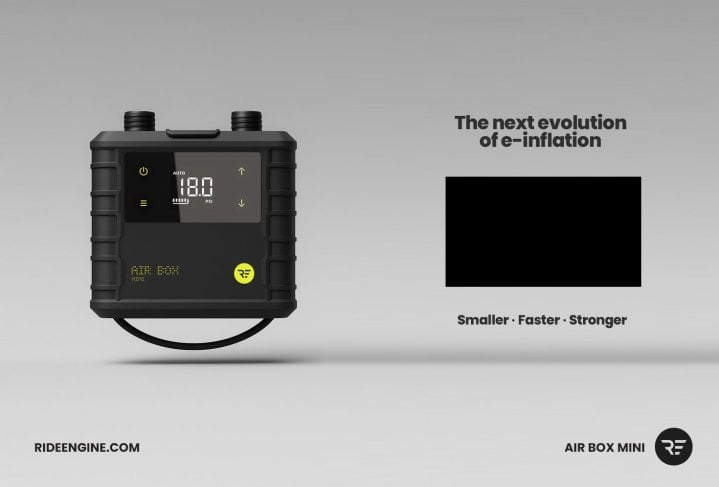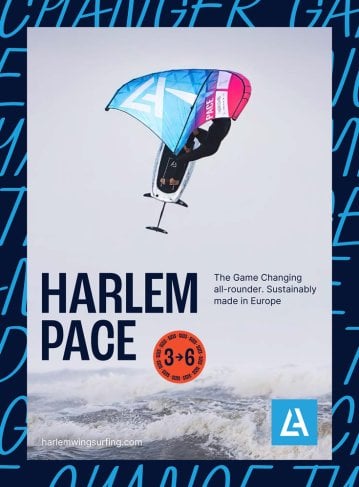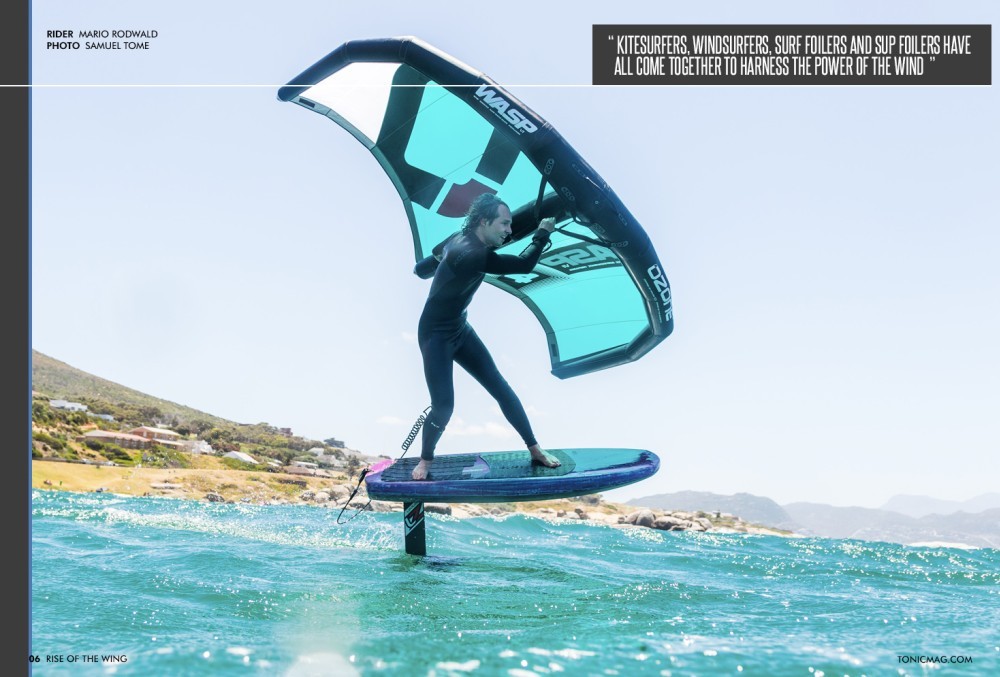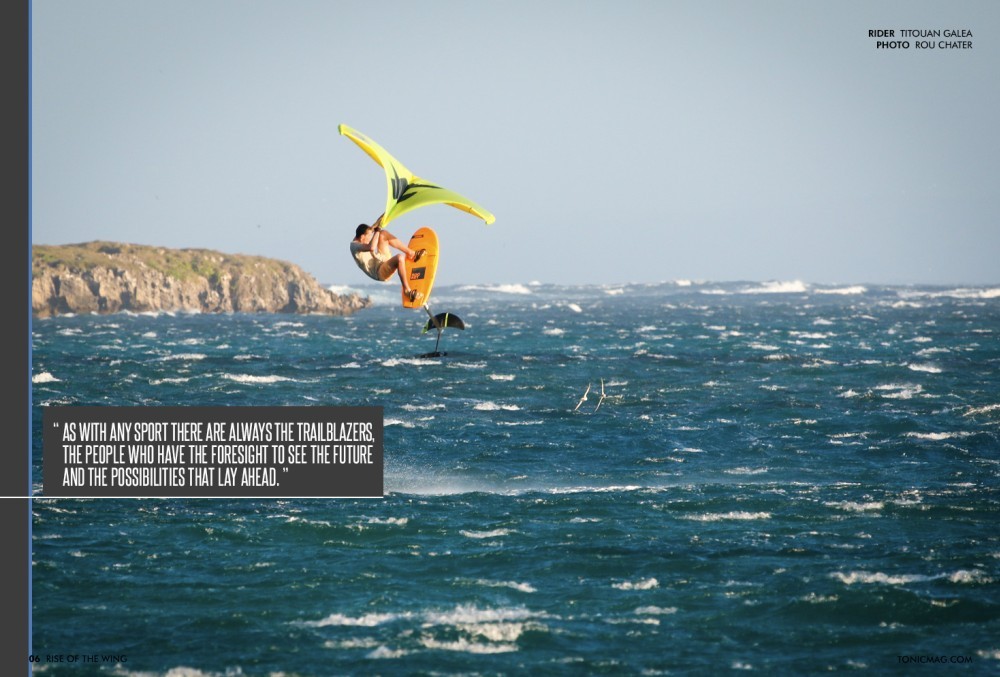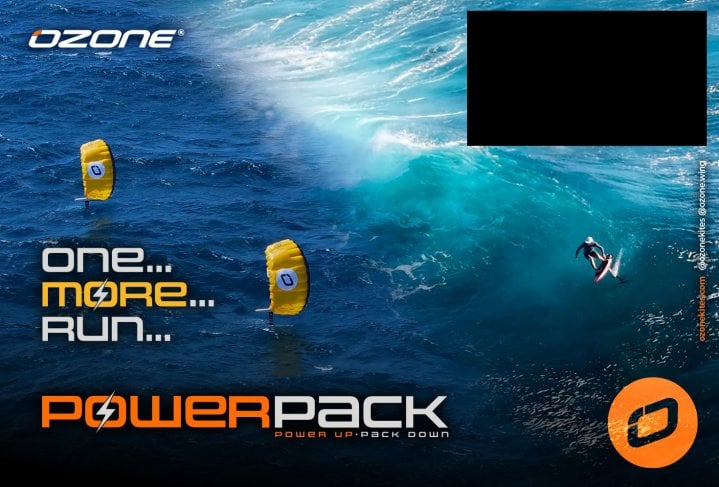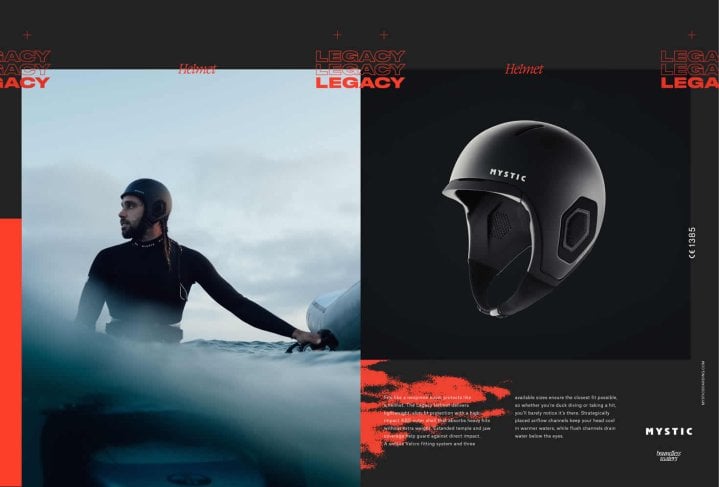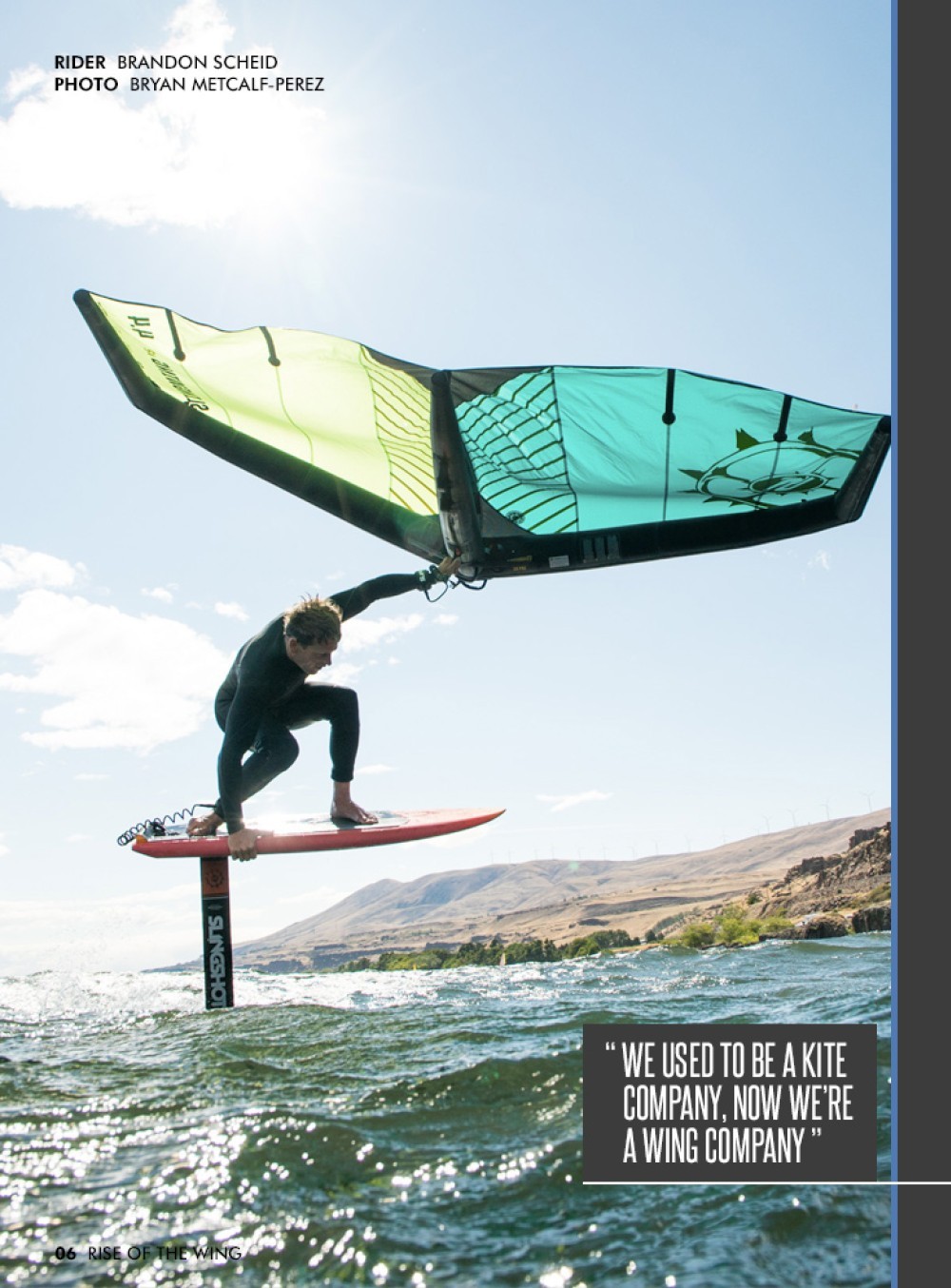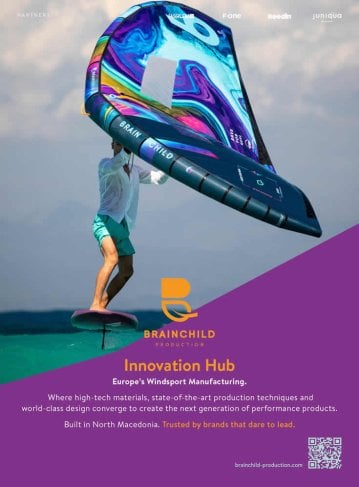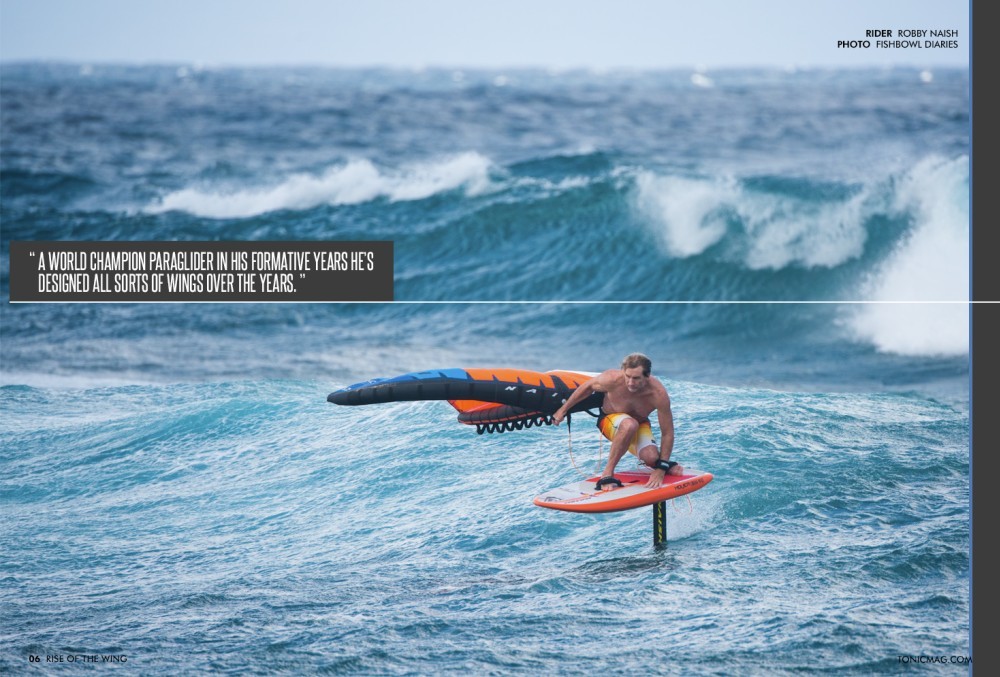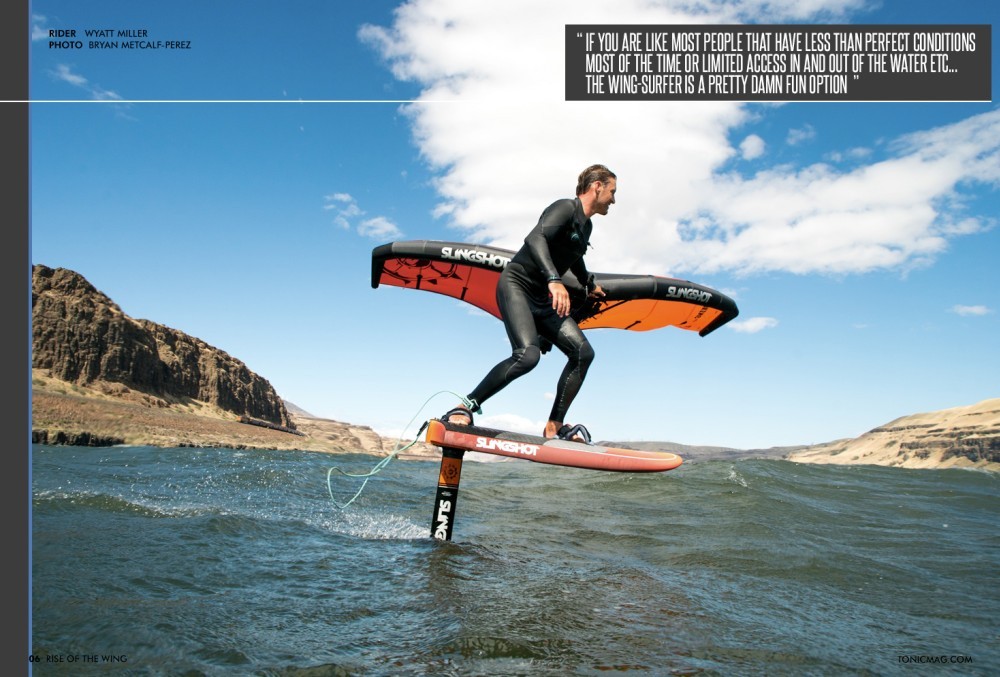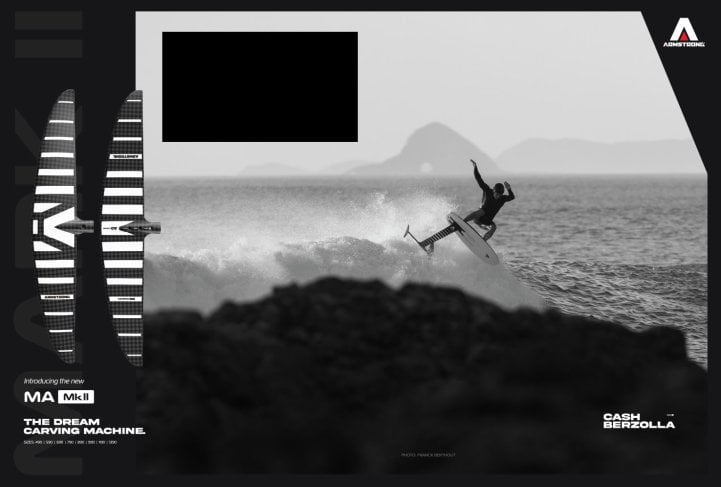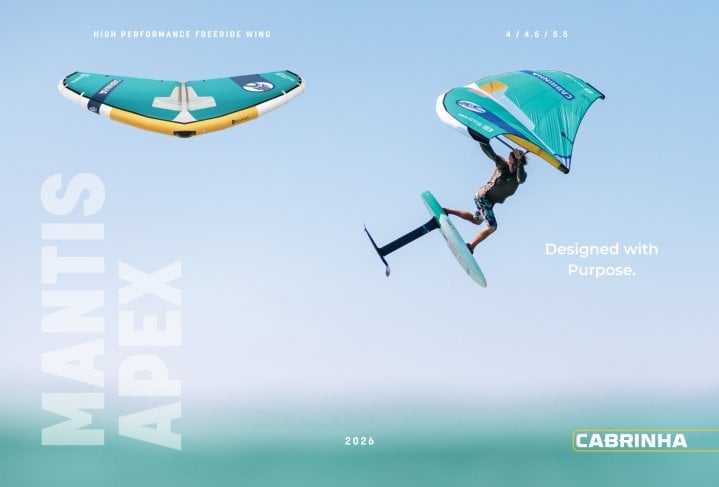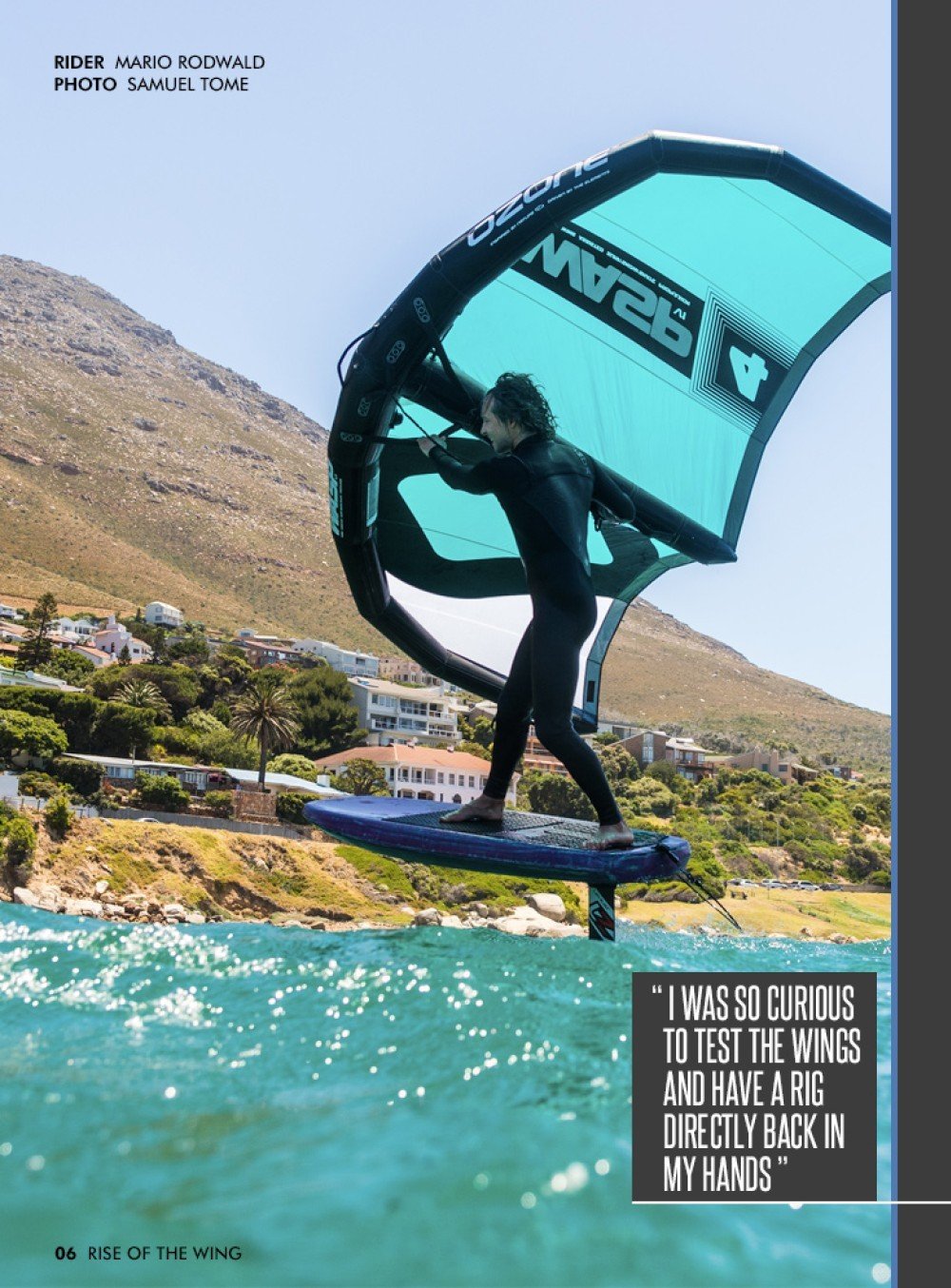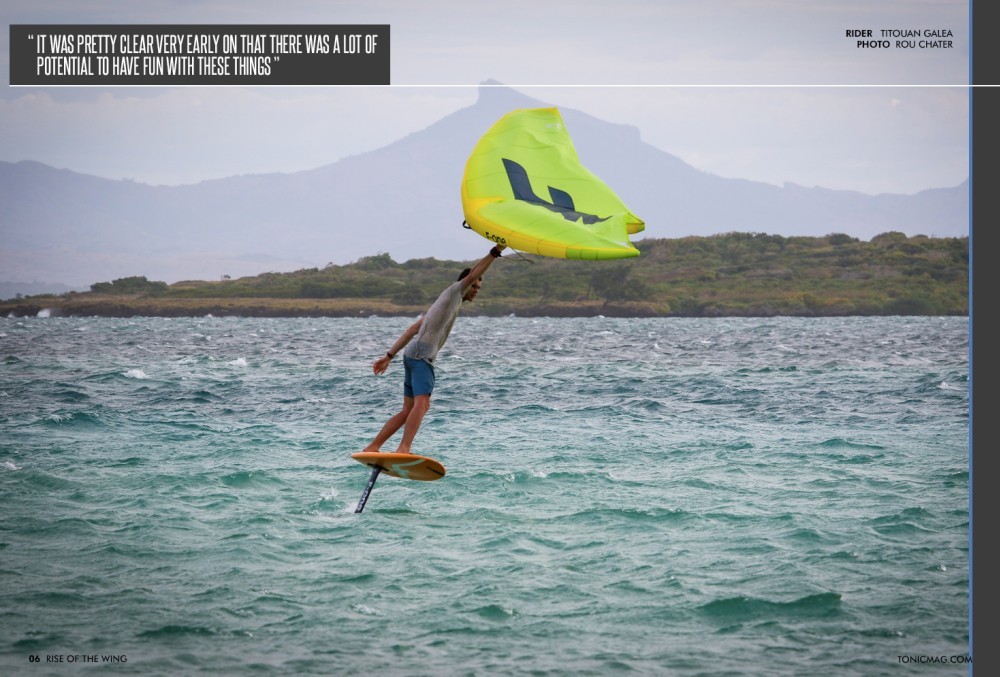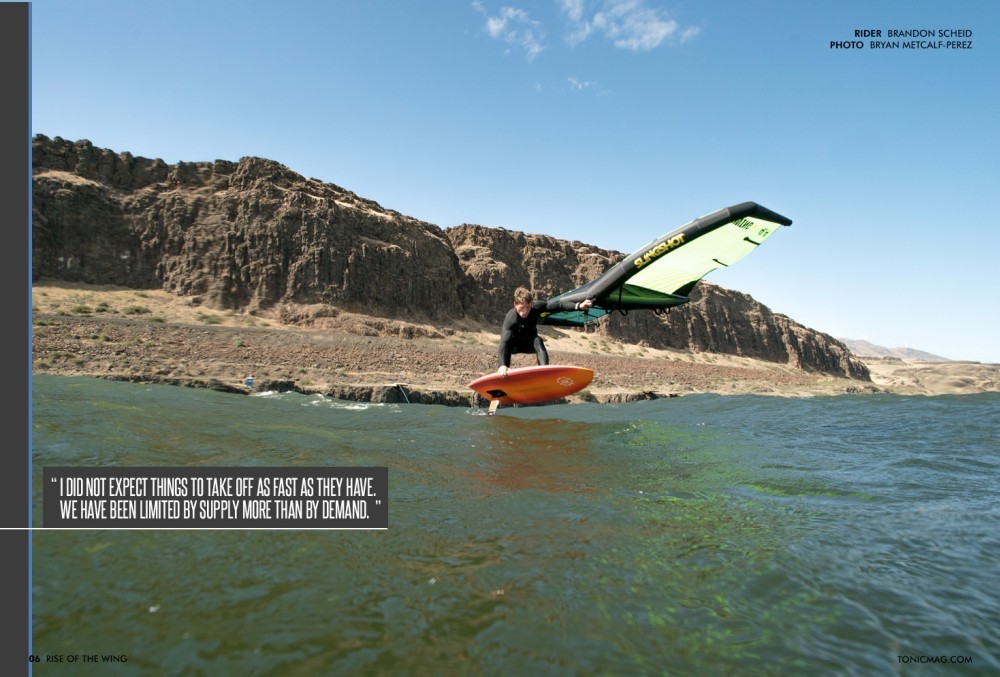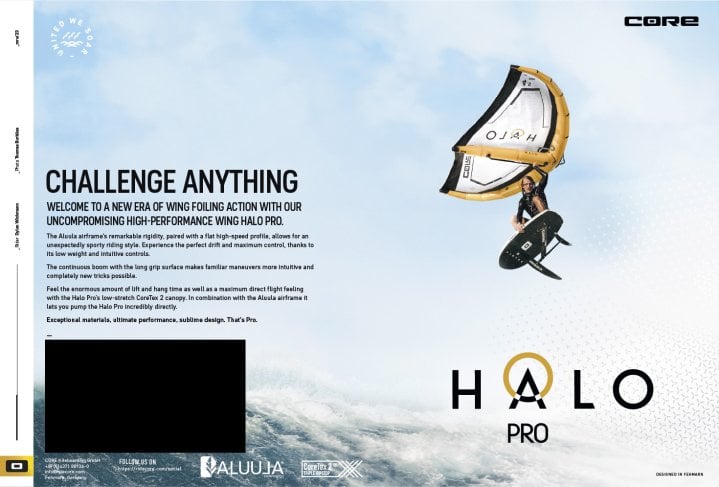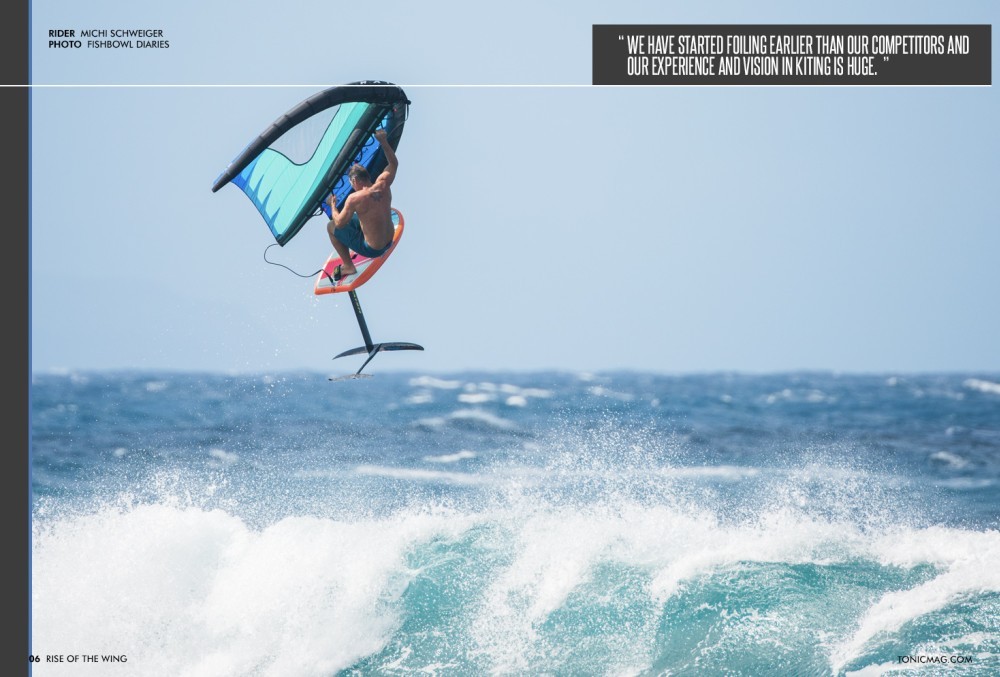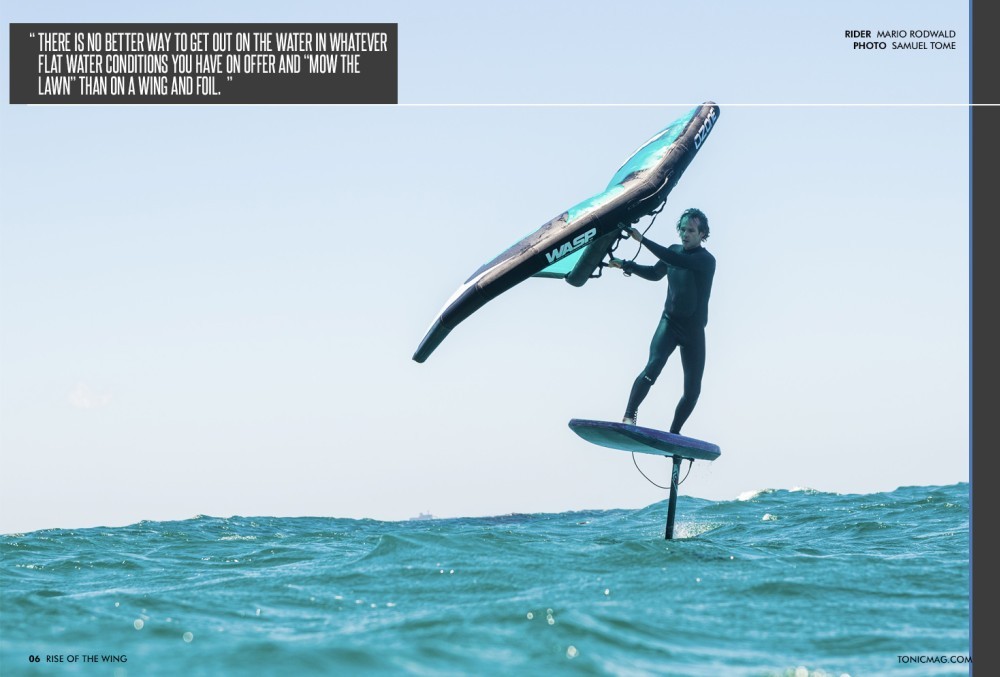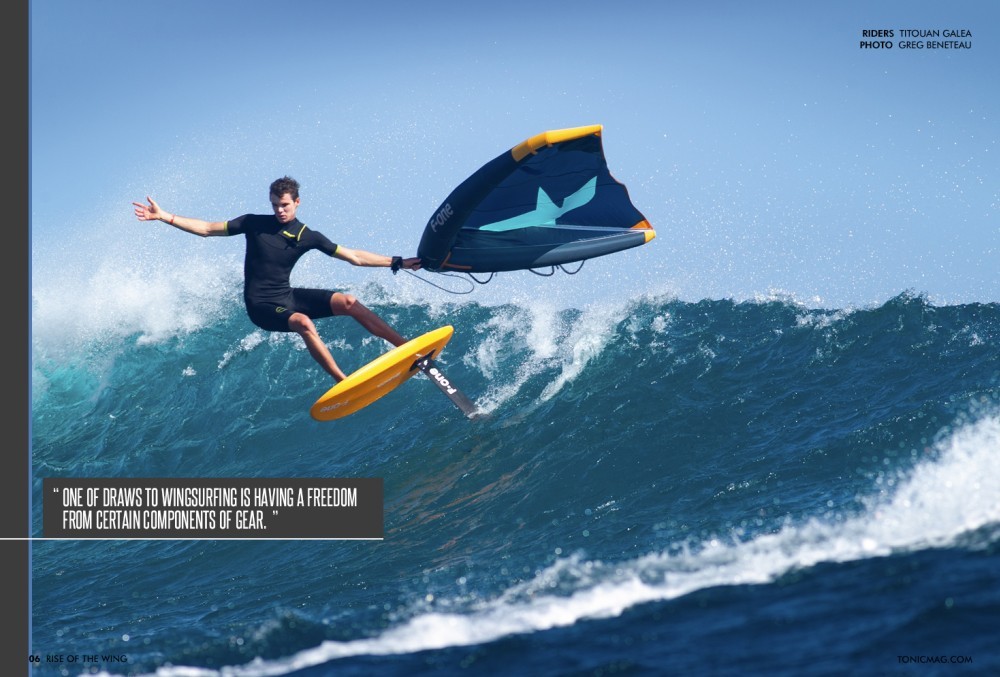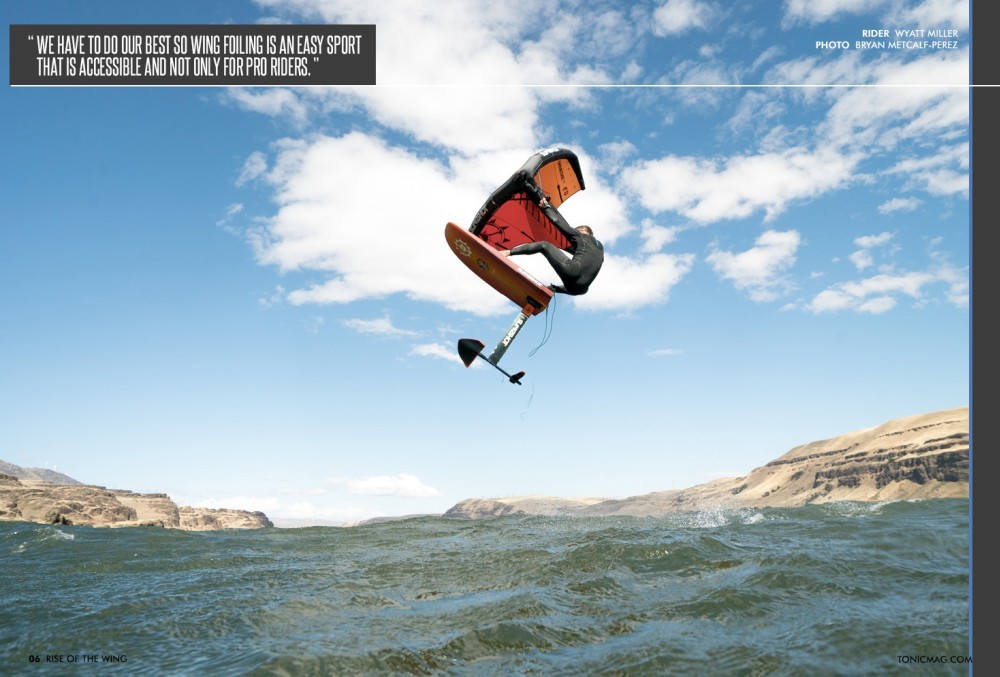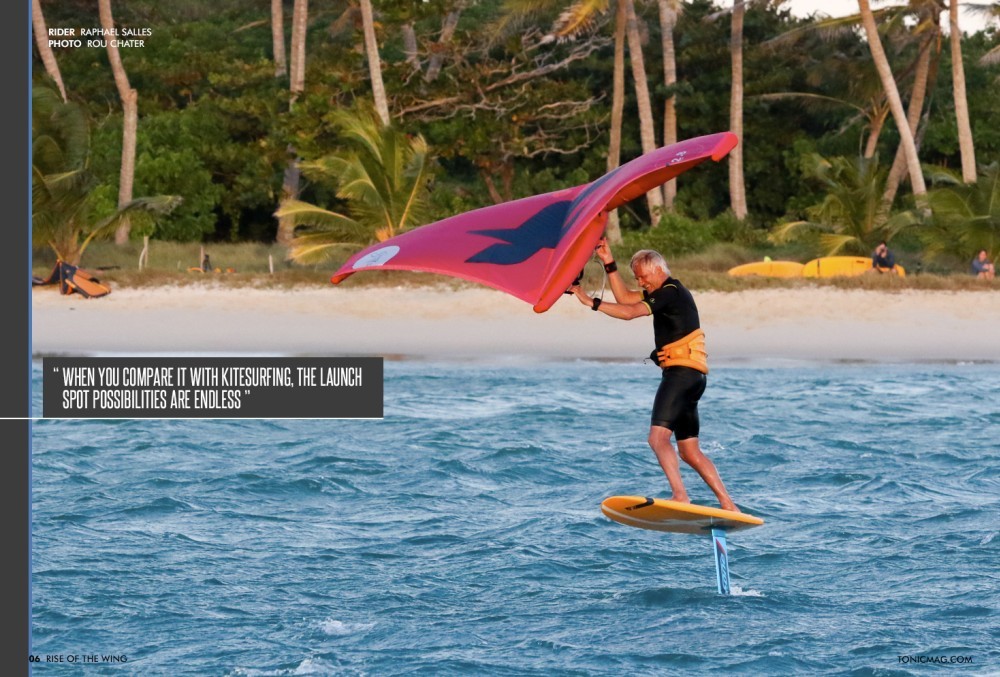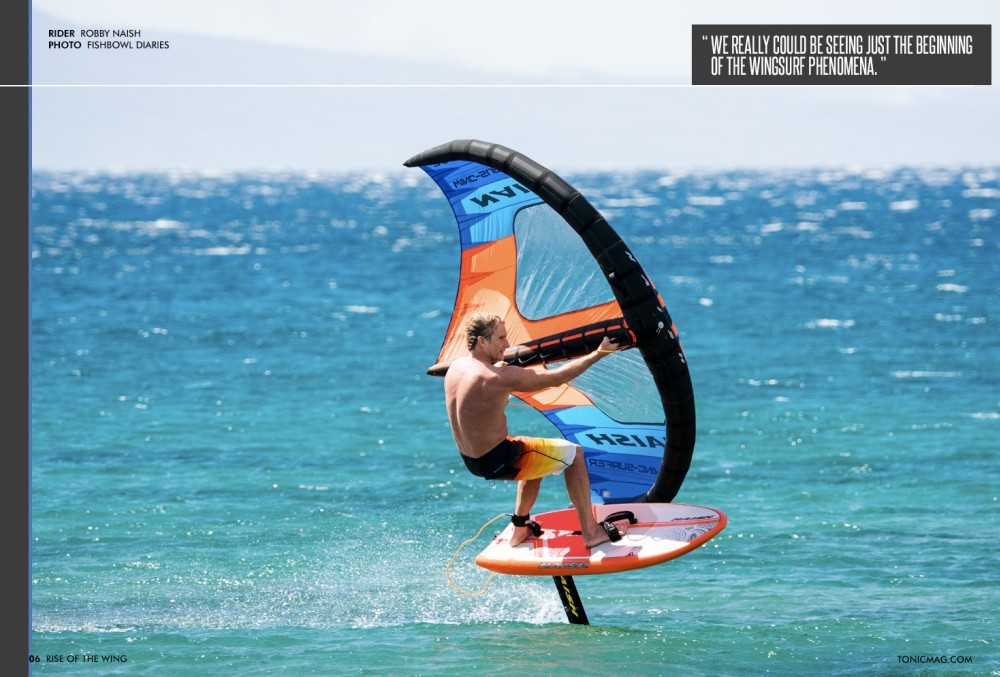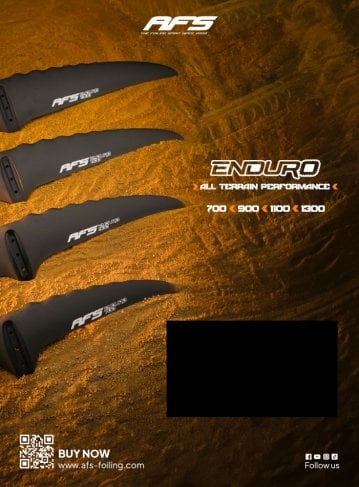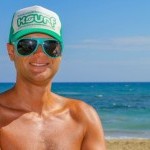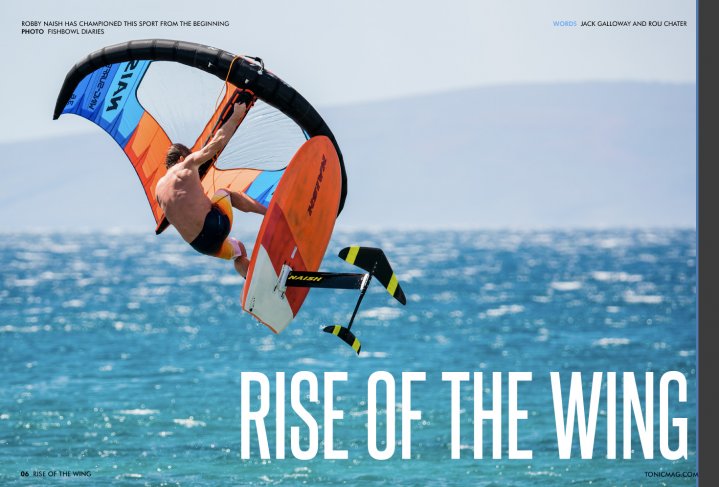
Rise Of The Wing
Issue 6 / Sun 8th Nov, 2020
It’s been around as we know it since 2015, but the origins date back much further than that. Thanks to a few dedicated pioneers the sport is going from strength to strength! We chat to Robby Naish, Raphael Salles, Tony Logosz and Rob Whittall about the boom of a sport and where it is headed. Find out about this incredible new sport and why you should get involved right here!
What we love about the wing is that it brings athletes and enthusiasts from a number of different watersports together. Kitesurfers, windsurfers, surf foilers and SUP foilers have all come together to harness the power of the wind using these incredible bits of kit and we’re big fans of that. Long gone are the days of windsurf and kitesurf rivalry.
The sport however isn’t as new as some of you might think. The earliest form of wing surfing that we could find was by Tom Magruder in 1986 on the Columbia River Gorge. His self designed ‘Wind Weapon’ was a rigid wing attached to a mast with a pivot that allowed him to ‘fly like a bird’. Check out the original clip of him in action in the video links within the article.
Unfortunately for Tom it didn’t take off, the main reason, we believe, being the friction encountered by a large conventional board, the clunkiness off the mast and moveable wing was also an issue. Compounding things further was the fact that at the time windsurfing was booming and the development of the sport was really taking off. The Wind Weapon just didn’t offer that many practical advantages over the sport of windsurfing.
Move forward a few decades to the 2010’s and another device called the Kitewing became popular in Europe. Used on frozen lakes and hard pack snow by ice skaters and skiers these rigid wings could allow their users to reach serious speeds but sadly, not do much else. The lack of friction on ice and snow made them effective, but on water they just weren’t that practical over the kites and sails currently in use.
Enter the age of the hydrofoil. With foiling technology developing fast, the friction problem encountered by Tom back in 1986 had suddenly been eliminated. Tony Logosz, Slingshot co-founder and designer was pictured in 2015 with the first prototype of the Slingwing in Hood River. Foils could now allow the wingsurfer to go upwind, head out in lighter winds and glide on rolling swell.
To this day we’re unsure why it took until 2019 for this sport to really blow up, some four years after its first inception. Arguably it was because the larger surface area foils just hadn’t been designed yet. It’s only in the last year or so we have seen foils in excess of 1800cm2 become popular and readily available. These larger foils make the sport far easier and more accessible for beginners. Since then, nobody has looked back, the sport is here to stay and it will keep on growing!
The Pioneers
As with any sport there are always the trailblazers, the people who have the foresight to see the future and the possibilities that lay ahead. We managed to track down some of the biggest pioneers in the sport and ask them about their journey with the wing. Of course there are always many more people involved, but these are some of the biggest names.
Raphael Salles, CEO at F-One has always been at the forefront of everything the company does. He appears in many of their videos shredding waves on a whole range of watercraft. He’s been pushing the wing hard since early 2019, arguably one of the first brands to have commercial success and as some of his own staff will admit, “We used to be a kite company, now we’re a wing company”.
23 times world champion windsurfer Robby Naish has spearheaded the Naish brand since 1996 when he moved away from commercial sponsorships. Since then his company expanded to be a leading brand in both kite and SUP. He’s always been at the forefront of new sports, first with kiting, then with SUP. When he dropped his YouTube video of the new Naish Wing early last year got thousands of hits. If Robby says it is going to be big, it usually is!
Cofounder and product designer at Ozone, Rob Whittall really knows his stuff. A world champion paraglider in his formative years he’s designed all sorts of wings over the years. From paragliders, kites and hydrofoils he’s an incredibly talent within the industry. When it Kai Lenny called asking for a wing, Rob got on the case and the rest is history.
Founded in 1999 by brothers Jeff and Tony Logosz, Slingshot Sports has always been about tinkering, exploring and finding the next great adventure. Tony is the designer behind some of the worlds most iconic kites, such as the Fuel and the RPM, he’s been a keen windsurfer and kiter in the Gorge for years and started playing with the wing concept back in 2015.
What would you say to someone who hasn’t tried the wing yet?
Rob Whittall: Being the direct connection between the wing and the foil is special, it's a new sensation that is very addictive and unique. We would always encourage people to have an open mind and give it a go, it might be one of the most sublime experiences of your life!
Raphael Salles: Wingsurfing is truly amazing. The feeling is like no other, pure gliding and a real freedom sensation. It's today a very accessible way to get the incredible feelings from foiling. After a bit of training the next major step is to surf small chops in free fly mode! It will give you access to the surf foiling world without being a surfer. After that you will be so passionate about the sport! You can also launch your wing equipment almost anywhere so its opening so many new spots which were previously closed to kiting.
Tony Logosz: Winging is the most accessible wind sport with the shortest learning curve. You can foil for miles on your knees without ever standing up. You can't say that about windsurfing or kiting. It is so intuitive that kids will be taking to it in droves, and if you are into wind sports and want your kids to partake. Get a wing for them to play with on the beach, with a skateboard, skimboard or just to jump off dunes with. They will learn so much about controlling the wind and have a total blast, next thing you know they will be begging to hit the water.
Robby Naish: If you have the time and the means, I would give it a go. If you are a kitesurfer and live somewhere with great conditions and easy access to the water etc...you might not rush into it. But if you are like most people that have less than perfect conditions most of the time or limited access in and out of the water etc...the wing-surfer is a pretty damn fun option to get you out on the water in a very engaging way with a really fast learning curve.
When did your brand first decide to start designing and testing their own wings?
Raphael Salles: We got into foiling in 2013, first for kiting and after for SUPing and surf foiling so the wing was naturally the next tool for us ! As a windsurfer before I was so curious to test the wings and have a rig directly back in my hands.
The first design Robert Graham sent to the factory was back in November 2018. We had received the prototype in December which we took to two trips to Cabo Verde and one to Cape town without being able to test it with our busy kite testing schedule.
It was only on the last day of our last trip to Sal in early March 2019 that we finally decided to test this first prototypes and wingsurf. After that day, we saw the full potential of the wing, and we worked very hard developing the SWING. It was such a passionate challenge to start from scratch without any idea of what a wing was and how it should work. In July 2019, our first production was out.
Robby Naish: We started making our first prototypes in the Fall of 2018 and launched the first Wing-Surfer to the market in the early Summer of 2019.
Rob Whittall: The decision was symbiotic to start designing wings! Kai Lenny was asking us for one, I was already keen to get involved in the sport and design one, so it was an easy decision to take.
Slingshot: Tony was playing with early prototypes back in 2015, the first Slingwing was in the market early in 2019.
Was it easy to convince the rest of the team that the wing had a future?
Robby Naish: Yes. It was pretty clear very early on that there was a lot of potential to have fun with these things. The simplicity and accessibility was too attractive for it not to take off.
Raphael Salles: We strongly believe that Wingsurfing is an ideal sport for F-ONE. We have the knowledge and a huge experience on how to build kites, boards and foils. After a few times wingsurfing and a trip to Mauritius to ride in waves, the team was hooked. Of course, it’s a different thing for the RandD team and the rest like communication or sales team, for them it was a totally new thing to add to their everyday work. So first reaction was like: one more crazy thing and now they are fully into it !
Rob Whittall: With the enthusiasm of Rob and Kai there was not a lot of convincing that needed to be done! These two characters are normally on point when it come to enjoying and exploring new sports.
What percentage of sales is the wing making up compared to other products at the moment?
Robby Naish: I knew that the Wing-Surfer was going to take off for us, but even I did not expect things to take off as fast as they have. We have been limited by supply more than by demand. We simply were not set up in terms of our material and manufacturing capacity to make enough wings for the growing global demand. We book our materials and production far in advance... and cannot simply snap our fingers and ramp up production capacity overnight and still maintain the quality that we demand. Others might do that, but we won’t.
So, growth is controlled and somewhat careful. That being the case, wing-surfing is clearly still growing and is a becoming a substantial percentage of our overall business both in terms of wings and wing-surfing boards and foils. We are lucky in that the Naish brand is showing very strong growth in many major markets with demand strong in all categories. We are investing heavily in our future and are still passionate about windsurfing, SUP, kiteboarding, foiling and of course wing-surfing. And although wing-surfing is a relatively new sport and already a very “crowded” segment in terms of the number of brands making wings etc (fortunately for us a lot of them being pretty much crap), for Naish it is already second only to kiteboarding.
Raphael Salles: Percentage is one piece of information, but we are more in a market leader position with wings and foils than in the kite market. We have started foiling earlier than our competitors and our experience and vision in kiting is huge. Robert our designer has worked on windsurf sails, delta planes and paragliding, this is a huge help to understand how to design a wing. Our goal is to keep ahead on wing and foil development with new design and technologies.
Rob Whittall: At the moment, wings are only a small part of our business but it's great to see it is motivating new people onto the water which is healthy for all water sports.
Tony Logosz: We are seeing strong demand across all our product lines. Winging is definitely a new and exciting category and we expect it will grow in the next few years.
We’re at the very early stages of the sport at the moment, with designs changing rapidly,
where do you see your brand going with wing design in the next few years?
Rob Whittall: If we had a crystal ball life would be too easy! Of course the sport will grow, there will be racing and big air/freestyle and all the things we normally do with these sports but we hope it will be a successful recreational sailing sport that transcends the finite aspects of racing and tricks. There is much to learn in terms of design and a huge potential for improvement but we will be concentrating on user friendly designs that everyone can enjoy. We like the idea of racing too because it filters design knowledge and performance into the rest of the products.
Raphael Salles: We are working on the design of the wingsurf gear the exact same way we do for the rest of our F-ONE range. We are developing in order to reach the perfect balance between performance and comfort so that every rider can enjoy their time on the water to the fullest, whether they are beginning to foil, riding in waves or crossing big downwind distances. Wings and foils designs are changing according to the sport evolution, we need to be ahead of the curve to be sure we are working on the right designs for the future.
Robby Naish: I love the simplicity of the sport. Right now, you can buy one wing in one size and pretty much “do everything” with it. But things develop rapidly as you know...and the sport will quickly “specialise” into different directions more quickly than I would like. I still see all- around “freeride” gear being the main market. There is no better way to get out on the water in whatever flat water conditions you have on offer and “mow the lawn” than on a wing and foil. It makes really crappy wind conditions really fun. But certainly, the higher performance side of things will also grow, with wave and freestyle being part of it as well as the more exciting side to me... the racing aspect. I see wing-foil racing becoming quite a big part of the sailing / foiling world. Naish will certainly be involved in all aspects of this new sport moving forward and I’m personally excited to see where things go.
Tony Logosz: I think wings will get a lot more powerful and efficient per size in the next few years. I think there is a lot of progress to make with wing shape, I think we could see double luff sleeves like racing windsurf sails to have a more efficient flow from LE to TE. There will also be a lot done in the handle department to stiffen them up and allow control with the wrists from wingtip to wingtip. Stiffer handles in all directions of force would allow for much more efficient pumping and better freestyle tricks.
How popular do you think the harness will be in wingsurfing?
Tony Logosz: Right now there is no question that one of draws to wingsurfing is having a freedom from certain components of gear. No bar and lines, no mast, and for some no harness. But, as we see the sport evolving at such a fast pace the advantages for using a harness is becoming more and more apparent. Harnesses afford a much needed rest letting the arms recharge thus allowing for longer sessions. Also, a harness and harness line lets the rider hold the wing in a more aggressive angle of attack longer for steeper upwind angles. I don't think it is a question of if a passionate, progression orientated wingsurfer will use a harness, it is more of when.
Raphael Salles: Being able to harness yourself to the wing has a real value when riding upwind in strong winds for miles, your arms can rest. Also it is good for people that are coming to the sport with less training than kitesurfers or windsurfers. We have to do our best so wing foiling is an easy sport that is accessible and not only for pro riders.
Rob Whittall: Harnesses are interesting but not necessary, we use them but don't feel it's a game changer so to speak because we also like a bit of physical effort too. Racers I am sure will be all over them but for recreation it's not a must have.
Robby Naish: Except in light winds with really big wings (above six meters) I really don’t see it being necessary. We will see where things go...but the fact that the harness is not an element of the sport right now, which for most people is part of what makes it so cool and free and unrestricted.
The Future
Unless you’ve had a long break from social media you’ll be more than aware of Jeffrey Spencer’s first back flip on a wing, a mighty impressive feat! Ridge and Kai Lenny followed just days later with the back flip and now front roll. But where will the sport go from here?
That’s what we find so exciting at Tonic Mag, nobody knows! Recently in Switzerland at the Engagawind event they had a fleet of wingsurfers course racing. It’s quite a spectacle seeing a fleet of wings lining up on a start line.
My personal draw to the sport is ‘downwingers’ and gliding on ocean swell in the hunt for new spots to explore. What a feeling. And when you compare it with kitesurfing, the launch spot possibilities are endless, this will open up accessibility for a huge number of people that just didn’t have the space before, inland lakes being just one great example.
There is also massive potential appeal to the masses, companies are attaching daggerboards to SUPs, which means you can now cruise upwind or get the whole family involved (make sure you have a look at our Toddler Wingsurfing article in this issue). Speaking of innovations the first inflatable foil boards are coming to market and they work well. Watch this space in our test section for when we get our hands on one.
In early September the first British Wingsurf instructor course took place in Portland. Organised by the BKSA in conjunction with the RYA and BSUPA and run by Andy Gratwick and Sam Ross. The two day course allowed instructors of the respective sports to convert their teaching skills to this new discipline. In terms of accessibility for schools, winging really is next level. At the low end instructors can keep their group in a small safe area on SUPs with daggerboards. At the high end schools can be running downwinger trips or wave coaching sessions.
At a worldwide level the Global Wingsports Association (GWA) has recently been set up by several founding partners to promote the sport. The GWA plan to ‘build a platform for all interest groups of wingsports, be it national, continental or international, with the aim to bring more people into wingsports’. They also have a world tour on the way so keep an eye out for that!
Finally…
What a sport to be a part of! With the equipment packing away easily in the boot of a car and the current climate meaning time spent outdoors is often the priority, we really could be seeing just the beginning of the wingsurf phenomena. Here in the UK it’s now rare not to see a wing at your local beach on a windy day.
The technology at our disposal is forever expanding, more efficient foils, more compact boards and lighter wings continue to come onto the market. Its super exciting to see where we’ll be in just a year let alone five years.
With watermen and women from all sports coming together to wingsurf stoke is at an all time high and we can’t wait to see where it takes us. See you on the water!
Videos
By Rou Chater
Rou Chater has been kitesurfing for over twenty years, paddleboarding for the last six years, and was there testing the first wingsurfer from Naish in Tarifa when it arrived on the continent. He is passionate about riding waves and exploring new places. As the publishing editor, he oversees everything at Tonic but also our sister magazines IKSURFMAG and IMB. He's been on the water since he was born and has never looked back, in the winter you'll find him chasing swells in the Caribbean and during the summer he can be found all over Europe at various SUP, Kitesurf and Mountain Bike events getting features for the magazines.


